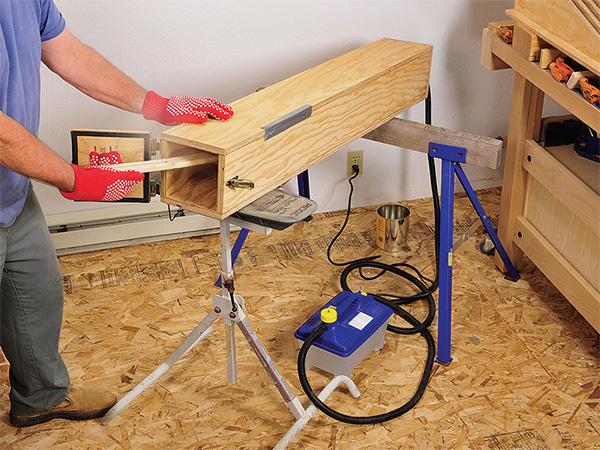
Recently, I was attempting to steam a piece of 3/32 x 3 x 28 spalted maple to bend it into an oval. It failed. My sample cupped, and when I went to bend it around the form, I got about 35 percent of the bend, then the wood cracked. My steam chamber is a 6′ piece of 6″ schedule 40 PVC with a 2-quart teapot steam supply. I steamed the wood for 30 minutes. Do you have any suggestions to improve my success? – Bob Puhlman
Rob Johnstone: I have a few points to make right off the top of my head. First, spalted wood fibers are degraded by the mildew/rotting process. That would make bending those fibers much more difficult, if not impossible. Second, maple is tough to bend by just clamping it around a form. Most guitar makers use a hot iron pipe to bend the wood around (heated with a torch or electrically). The wood is boiled or soaked in water for a good while, then bent around the heated iron and then clamped to a form. With that said, bending wood is always a sketchy task that can often end in a surprising snapping sound. If you really want that spalted look, I would make the shape from bending plywood and then apply spalted maple veneer. (There is always another way to skin a woodworking cat.) There may be more issues related to steaming maple that I am not aware of (I have bent maple using a hot iron but not steaming it); I will ask around our pool of experts.
Tim Inman: Bending anything spalted would be tricky. Spalted wood is, by definition, beginning to weaken and rot. Bent wood needs to have its long fibers intact and strong. So, we’re one back to start. That said, “Never give up!” is my motto. To make that bend, you’ll need some serious heat (steam) and some time. I like to have my wood for bending wet. I usually soak it overnight. I find that soaking the wood in water with fabric softener is a big plus. Then, bending day, I start my steamer and put the wood in. I allow at least one hour of steam per one inch of thickness, minimum. The heat needs to penetrate all the way to the core of the wood. You’ll need more than a two-quart teakettle for steam. Think fish boil kettle with a tight lid and tube. You’ll end up with something that looks like a moonshine operation. Think about steam pressure, too. Don’t blow anything (you) up in the process.
When you make the bend, you need to act fast! The wood takes a long time to heat, but cools amazingly fast. Rehearse! You do not have time to pull the wood out of the steamer and then think about how you’re going to do the bending. Rehearse the moves! You’ll need a form to bend around, and you’ll need a compression strap. A compression strap goes on the outside or “long” side of the curve. Heated wood fibers have very little ability to resist pulling apart, and fail on the “outside” of the bend. A compression strap (which can be something as simple as metal plumbers hanger strapping) keeps the outside dimension stable and forces the dimensional change to the inside or ‘short’ side of the curve. Without a compression strap keeping the wood together, it is just about impossible to make bends without the wood splitting out and failing.
Once the bend is made, clamp the wood in place around the form and let it stay for a day or two – depending upon thickness. Let it cool off and dry out in place. When you release it, expect some spring-back. My Granddad was an old-time blacksmith and wheelwright. Buggy wheel rims are bent wood. I’ve helped bend many. It isn’t always successful, but it is always exciting! Work fast, rehearse; if you need two, bend four.





